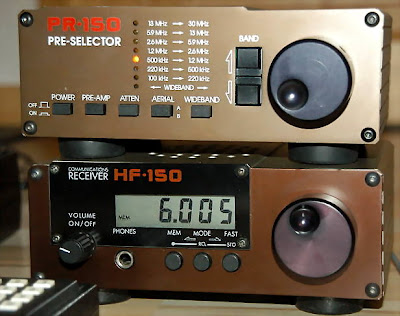
Lowe produced a antenna preselector for the HF-150 to overcome the problems associated with overloading from strong signals, Lowe PR-150 preselector and preamp. The PR-150 covers 100 kHz to 30 MHz in seven bands segments. Each band segment comprises of a dual-tank LC filter circuit, each of which can tune over 2.5:1 within the intended frequency range.
Each filter is passive. For additional gain, there is a built in UHF bipolar transistor preamp which has low noise performance with a high dynamic range. There is also a broadband setting that can be used. The preamp may be switched in or out. The PR-150 also features an Attenuator and A/B antenna switch for 2 antennas.
It is built in a very solid metal alloy case matching the HF-150. On the back panel there is an Antenna A input (SO-239 or Hi-Z terminals) and an Antenna B input (Hi-Z terminals). Output to the receiver is 50 ohm impedance - SO-239. The unit requires 12 VDC at 50 ma. (and has a duplicate socket for power loop-through to other accessories).
The overall performance of the HF-150 is improved many fold when fitted to the PR-150 and I would deem that this is an essential component for the HF-150 if you wish to receive peak performance from your HF-150.
 Even if you do not have a HF-150 and you are looking for something in the way of a preselector for your HF receiver, the PR-150 is probably a very wise choice.
Even if you do not have a HF-150 and you are looking for something in the way of a preselector for your HF receiver, the PR-150 is probably a very wise choice.
Link to PR-150 Operation Manual (Pdf)
| Specifications |
|---|
Frequency coverage ......... 100 kHz to 30 MHz |












